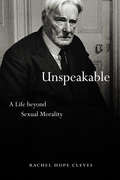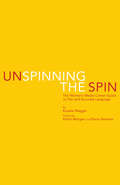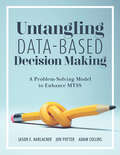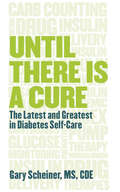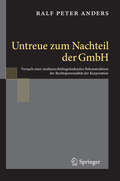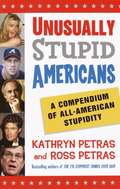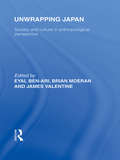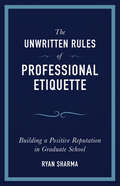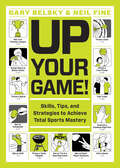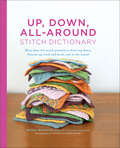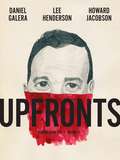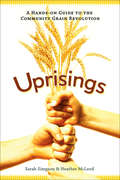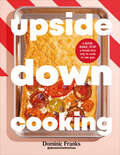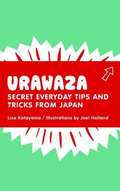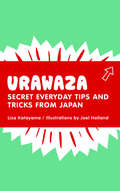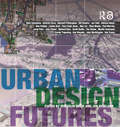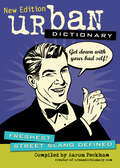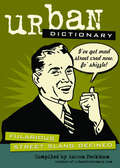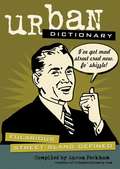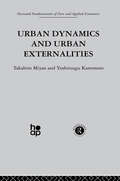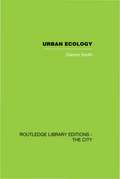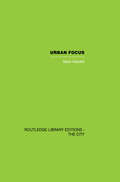- Table View
- List View
Unspeakable: A Life beyond Sexual Morality
by Rachel Hope ClevesThe sexual exploitation of children by adults has a long, fraught history. Yet how cultures have reacted to it is shaped by a range of forces, beliefs, and norms, like any other social phenomenon. Changes in how Anglo-American culture has understood intergenerational sex can be seen with startling clarity in the life of British writer Norman Douglas (1868–1952), who was a beloved and popular author, a friend of luminaries like Graham Greene, Aldous Huxley, and D.H. Lawrence, and an unrepentant and uncloseted pederast. Rachel Hope Cleves’s careful study opens a window onto the social history of intergenerational sex in the nineteenth and twentieth centuries, revealing how charisma, celebrity, and contemporary standards protected Douglas from punishment—until they didn’t.Unspeakable approaches Douglas as neither monster nor literary hero, but as a man who participated in an exploitative sexual subculture that was tolerated in ways we may find hard to understand. Using letters, diaries, memoirs, police records, novels, and photographs—including sources by the children Douglas encountered—Cleves identifies the cultural practices that structured pedophilic behaviors in England, Italy, and other places Douglas favored. Her book delineates how approaches to adult-child sex have changed over time and offers insight into how society can confront similar scandals today, celebrity and otherwise.
Unspinning the Spin
by Rosalie Maggio The Women's Media CenterThe Women's Media Center--founded by Jane Fonda, Gloria Steinem, and Robin Morgan--presents its first comprehensive guide to using accurate, inclusive, creative, and clear language. At a time when language is too often used to "spin" instead of communicate, Unspinning the Spin: The Women's Media Center Guide to Fair and Accurate Language was created to help everyone understand and be understood. Unspinning the Spin offers the convenience of a dictionary, the authority of a usage guide, the helpfulness of a thesaurus, and the wit and wisdom of an entertaining and authoritative teacher of the subject. Organized alphabetically for easy use, with cross-references to related words, phrases, and issues, this book goes beyond the scope of the usual reference book. It mines a wide variety of fields to present the background, current uses, accuracy, alternatives, and best practices for choosing and decoding common words and phrases, and offers a trove of suggestions for bias-free language. Unspinning the Spin is a practical, indispensable how-to that is fun to read. It's invaluable for journalists, bloggers, students, teachers, government officials, and communications professionals, and it will be compelling for any reader who loves the English language. The author, Rosalie Maggio, has been an expert and widely read authority on language for more than 25 years. She is the author of the award-winning Dictionary of Bias-Free Usage and the editor of The New Beacon Book of Quotations by Women. Unspinning the Spin includes a preface by Robin Morgan, feminist activist, former editor-in-chief of Ms., and award-winning author of more than 20 books; and Gloria Steinem, writer, activist, editor, bestselling author, and cofounder of Ms. This book is the first publication of WMC Press, the publishing arm of the Women's Media Center. "Given the growing awareness of sexism imbedded in our everyday speech, we--and the news media in particular--need alternative language. Unspinning the Spin should be a welcome resource for journalists, and for anyone who works with words, to consult. At last we have a comprehensive, authoritative (and funny!), feminist Fowler's." --Suzanne Braun Levine, author, first editor of Ms., and first woman editor of The Columbia Journalism Review "Language is power and debates are won or lost on how the arguments are shaped. Anyone who cares about politics, power, and the histories we make today will find Unspinning the Spin: The Women's Media Center Guide to Fair and Accurate Language a reference for all seasons." --Katrina vanden Heuvel, Editor and Publisher of The Nation
Untangling Data-Based Decision Making: A Problem-Solving Model to Enhance MTSS
by Adam Collins Jason E. Harlacher Jon PotterThis book offers knowledge, strategies, and tools that will help you use data effectively. Applicable to any content area, the four simple steps in this book’s problem-solving model include specific questions that will guide your use of data to identify and solve problems that stand in the way of student achievement. Learn how to change instruction, curriculum, and environment to better support students.
Until There Is a Cure
by C. D. E. Gary ScheinerThe treatment of diabetes is ever-changing as technologies progress; as new medications are discovered, tested, and approved; and as researchers uncover breakthrough findings in the field of endocrinology..In Until There Is a Cure: The Latest and Greatest in Diabetes Self-Care, respected Certified Diabetes Educator and author Gary Scheiner delivers the most up-to-date information and analysis on groundbreaking developments in the world of diabetes. Scheiner's commentary is founded not only in his professional experiences and expertise as an educator, but also in over 25 years of successfully managing his own type 1 diabetes..Until There Is a Cure: The Latest and Greatest in Diabetes Self-Care is the perfect book for people with diabetes, their spouses, friends, and families, diabetes educators, or healthcare professionals who require the most current, relevant information on advancements in diabetes research, technologies, and treatments.
Until There Is a Cure
by C. D. E. Gary ScheinerThe treatment of diabetes is ever-changing as technologies progress; as new medications are discovered, tested, and approved; and as researchers uncover breakthrough findings in the field of endocrinology..In Until There Is a Cure: The Latest and Greatest in Diabetes Self-Care, respected Certified Diabetes Educator and author Gary Scheiner delivers the most up-to-date information and analysis on groundbreaking developments in the world of diabetes. Scheiner's commentary is founded not only in his professional experiences and expertise as an educator, but also in over 25 years of successfully managing his own type 1 diabetes..Until There Is a Cure: The Latest and Greatest in Diabetes Self-Care is the perfect book for people with diabetes, their spouses, friends, and families, diabetes educators, or healthcare professionals who require the most current, relevant information on advancements in diabetes research, technologies, and treatments.
Untreue zum Nachteil der GmbH: Versuch einer strafunrechtsbegründenden Rekonstruktion der Rechtspersonalität der Korporation
by Ralf Peter AndersDie Arbeit untersucht Grund und Grenzen der Dispositionsbefugnis der Gesellschafter über das GmbH-Vermögen im Rahmen der sog. Organuntreue. Der normative Zusammenhang zwischen der juristischen Person und ihren natürlichen "Hinterleuten" wird in einem neuartigen und grundlegenden Zugang in seinem spezifisch gesellschaftsrechtlichen Kontext in Beziehung zu rechtsphilosophischen Begründungszusammenhängen gesetzt, indem in Abgrenzung zu insbesondere systemtheoretischen und ökonomischen Ansätzen die Grundbegriffe Person, Institution und Korporation unabhängig von kontingenten funktionalistischen und wirtschaftlich-utilitaristischen Erwägungen über ein freiheitlich-intersubjektives Anerkennungsverhältnis bestimmt werden. Die Grenze einer Dispositionsbefugnis der GmbH-Gesellschafter wird dabei über eine unternehmensbezogene teilhabegerechtigkeitstheoretische Aktualisierung der Kantischen Privatrechtslehre entwickelt.
Unusually Stupid Americans: A Compendium of All-American Stupidity
by Kathryn Petras Ross PetrasA hilarious collection of lists, statistics, news items, quotations, and facts detailing stupid acts of Americans from all walks of life—by the authors of the bestselling The 776 Stupidest Things Ever SaidEveryone knows that America is “the land of the free and the home of the brave,” but sometimes that means we’re free to be as bravely stupid as we want! In Unusually Stupid Americans, Kathryn Petras and Ross Petras assemble choice bits of stupidity, U.S.A.-style, including•the top seriously flawed American advertising moments, including Pacific Airlines’ brilliant “You’re scared of flying? So’s our pilot!” ad campaign, which led the airline to bankruptcy within two months of the campaign’s inception•the Martin Luther King, Jr., celebration in Florida, where a plaque was un-veiled that was intended to honor the actor James Earl Jones but instead read, “Thank you James Earl Ray for keeping the dream alive” (an unfortunate slip-up, as James Earl Ray was King’s assassin)•and much more!
Unwrapping Japan: Society and Culture in Anthropological Perspective (Routledge Library Editions: Japan)
by Eyal Ben-AriRecent years have witnessed an explosive growth in the literature published about Japan. Yet it seems that the more that is written about Japan and Japanism – its culture, society, people – the more mysterious it becomes. As well as exploring issues relating to advertising, tourism, women, festivals and the art world, the book depicts how the study of Japanese society contributes to anthropological theory and understanding. The editors use the term ‘unwrapping’ to provide insights into Japanese culture and relate these insights to broader problems and questions prevalent in contemporary anthropological discourse. The issues explored include the contribution of applied anthropology to theory; the relationship between tourism and nostalgia; the interplay of marginality and belonging; the role of advertising in gender relations; status in the art world and the place of Japanese genres of writing within anthropology texts.
Unwritten Rules of Professional Etiquette: Building a Positive Reputation in Graduate School
by Ryan SharmaDid you know that no one cares about your grades in graduate school because everyone gets As? Did you know that all students are doing extra activities to pad their CVs and resumes? Do you wonder how you are supposed to stand out among your peers and get access to special projects, training opportunities, or internship placements? Do you know the common faculty annoyances that may spoil your chances at these opportunities? <P> A truly professional demeanor will give you access to a competitive edge, yet there are many unwritten expectations that-if you are not aware of them-can jeopardize your reputation. The Unwritten Rules of Professional Etiquette gives you an honest account of the ways faculty silently judge students without pulling any punches. With this straightforward advice you can sidestep the hidden graduate school pitfalls and emerge at the top of your class. Covering topics such as excelling in interviews, responding to constructive feedback, and dealing with difficult faculty, this compendium is an essential resource for navigating the complex world of academic relationships. While this is an indispensable handbook for graduate students, undergrads practicing this advice will be truly outstanding.
Up Your Game!: Skills, Tips, and Strategies to Achieve Total Sports Mastery
by Gary Belsky Neil FineSound smart and play smarter with this compendium of the tricks, techniques, and unwritten rules every sports fan needs—from naming your fantasy team to betting with friends, doing a flip turn to investing in memorabilia, winning at arm wrestling to hosting a Super Bowl party, and so much more. With over 150 to-the-point entries, plus helpful illustrations, charts, and lists, Up Your Game! will get you in the know in no time.
Up, Down, All-Around Stitch Dictionary: More than 150 Stitch Patterns to Knit Top Down, Bottom Up, Back and Forth, and In the Round (Stitch Dictionary Ser.)
by Wendy BernardThis “super useful book” includes step-by-step instructions for using each of the 150 patterns four different ways (Knitty).In the Up, Down, All-Around Stitch Dictionary, designer Wendy Bernard presents an innovative reference guide for knitters of all skill levels. This hefty collection, ranging from lace and cables to colorwork and fancy edgings, is loaded with beautifully photographed swatches of each pattern, plus charted and text instructions. Bernard also demonstrates how to work each of the 150 popular stitch patterns four different ways: top down, bottom up, back and forth, and in the round. And to showcase the stitch patterns in action, she includes instructions for eight garments as well as her famous formulas for knitting garments without a pattern.
Upfronts Volume 4
by Various VariousUpfronts is a semi-annual digital publication that features selections from new and upcoming Hamish Hamilton titles. Download your copy and discover the most exciting writing Canada and the world has to offer. Volume 4, released in summer 2014, features an exclusive preview of Howard Jacobson's new novel J, as well as selections from Lee Henderson and Daniel Galera.
Uprisings: A Hands-On Guide to the Community Grain Revolution
by Sarah Simpson Heather McLeodThis practical guide explores the food security and community sufficiency benefits of growing local grain—and shows you how easy it is to get started.If we want to reduce our environmental impact, build resiliency in our community, and improve food security, it's up to us to make it happen. Uprisings shows how communities across North America can take action by reviving local grain production.Environmental journalist Sarah Simpson profiles of ten unique community models demonstrating how local grain production is already making a difference. She then shares step-by-step instructions for small-scale grain production that will turn any community into a hotbed of revolution. Learn about:How locally grown wheat, barley, and other grains can impact a communityHow to start a community grain project from scratchHow to plant, grow, harvest, thresh, winnow, and store your grainHow to use whole and sprouted grains in your kitchen
Upside Down Cooking: LAYER, BAKE, FLIP A Brand New Way to Cook in One Tray
by Dominic FranksThe book that flips your kitchen upside down, with joyfully delicious results. Dominic Franks (@dominthekitchen) shows you how to play with your food and cook easy, impressive meals for every occasion. This is one-pan cooking like you've never seen it before. With 85 recipes including twists on classic one-pot dishes – from mini puff pizzas to chicken pot pies, blueberry muffin traybakes to banana toffee tarts – Dom gives you the confidence to remix your own one-tray dinners, plus sides, snacks, party treats, and desserts. Simply layer up tasty ingredients in a single pan, cover with puff pastry and other fabulous toppings, bake to gloriously golden perfection – and you’ll be turning out stunning upside down creations in no time at all. No fuss, minimal washing up, and never a soggy bottom in sight!
Urawaza
by Joel Holland Lisa KatayamaJapan has a way of thinking that is just...different. Nowhere is this more apparent than in Tokyo-born journalist Lisa Katayama's collection of urawaza (a Japanese word for secret lifestyle tricks and techniques). Want to turbocharge your sled? Spray the bottom with nonstick cooking spray. Can't find someone to water your plants while you're away? Place the plant on a water-soaked diaper, so it slowly absorbs water over time. The subject of popular TV shows and numerous books in Japan, these unusually clever solutions to everyday problems have never before been published in English--until now! Urawaza collects more than 100 once-secret tricks, offering step-by-step directions and explanations.
Urawaza: Secret Everyday Tips and Tricks from Japan
by Joel Holland Lisa KatayamaJapan has a way of thinking that is just...different. Nowhere is this more apparent than in Tokyo-born journalist Lisa Katayama's collection of urawaza (a Japanese word for secret lifestyle tricks and techniques). Want to turbocharge your sled? Spray the bottom with nonstick cooking spray. Can't find someone to water your plants while you're away? Place the plant on a water-soaked diaper, so it slowly absorbs water over time. The subject of popular TV shows and numerous books in Japan, these unusually clever solutions to everyday problems have never before been published in English—until now! Urawaza collects more than 100 once-secret tricks, offering step-by-step directions and explanations.
Urban Design Futures
by Malcolm Moor Jon RowlandThe last decade has seen the rise of urban design which has taken a central position in the new agendas for urban regeneration and renaissance. Urban design has moved from marginality to mainstream. The principles espoused by urban designers over the past thirty years are now accepted as key to a better urban environment and as we move towards greater sustainability, different ideas are emerging that are challenging some of the accepted urban design norms; urban design is at a watershed. Urban Design Futures presents essays from an international cast of authors to review progress and explore emerging ideas: should urban design reflect the future rather than recreate the past? What are the new driving forces that will shape urban living and hence urban design in the future? This book explores new concepts and points the way towards a series of urban design paradigms for the twenty-first century.
Urban Dictionary: Freshest Street Slang Defined (Urban Dictionary Ser. #3)
by Aaron PeckhamThe ultimate authority on street slang presents a new volume of delightfully dirty, surprisingly insightful terms and phrases.In 1999, Aaron Peckham established UrbanDictionary.com, inviting users to define their world by compiling the most epic collection of slang in history. Since then, the site has skyrocketed in popularity, amassing thousands of definitions and edumacating millions. Users submit about 2,300 new entries every day!In this totally and awesomely revised edition of the best-selling original, readers will find defs—mostly new, some updated, and all fularious—for the most current word creations.
Urban Dictionary: Fularious Street Slang Defined (Urban Dictionary Ser. #1)
by Aaron PeckhamThe creator of Urban Dictionary shares a compendium of the site&’s funniest, weirdest, and truest entries. Since 1999, UrbanDictionary.com has become the undisputed authority on contemporary slang. The site&’s creator, Aaron Peckham, invites its ever-expanding fanbase to submit new words and definitions. For Urban Dictionary: Fularious Street Slang Defined, Peckham has curated a choice selection of terms that will definitely earn you street cred, and help newbies avoid confusing shank with skank.
Urban Dictionary: Fularious street slang defined
by Aaron PeckhamFounder Aaron Peckham culls his more than 170,000 definitions for the funniest, and most provocative phrases that define the modern slang scene. Within urbandictionary. com's lively lexicon are: * business provocative-Attire used to provoke sexual attention in the workplace. * compunicate- To chat with someone in the same room via instant messenging service instead of in person. * dandruff- A person who "flakes out" and ditches their friends. * wingman- A guy who takes one for the team by hooking up with a hot girl's ugly friend so his own friend can hook up with the hot girl. Perfect for those who want to pick up some new slang and those who want to translate it, Urban Dictionary is a gritty and witty look at our ever-changing language. Urban Dictionary covers the language that encompasses the trials and tribulations that anyone under 30 encounters-and leaves everyone over 30 scratching their heads but wanting to know more.
Urban Dynamics and Urban Externalities
by Y. Kanemoto T. MiyaoThis title combines reviews of two of the most important branches of urban economics: dynamics and externalities.
Urban Ecology
by Dianne SmithThere are many micro-habitats in built up areas, often subject to strong environmental pressures such as atmospheric and water pollution, frequent disturbance, trampling, nutrient or water scarcity, etc. In Urban Ecology Dianne Smith uses such features as footpaths, walls, gravestones, gardens, compost heaps and derelict land to investigate the effects of these pressures and to demonstrate other ecological properties of oftern isolated habitats. This book was first published in 1984.
Urban Focus
by Mark HewlettThis project is aimed the 16+ age range inside or outside any kind of educational institution. It is for courses concerned with general education - either in general studies programmes or as aspects of specialist teaching. Narrative has been kept to a minimum. Instead, the books are more a collection of different items of teaching and learning materials: for example, the collection of key concepts, and the list of key questions connected withe the study. The books are compact in content and flexible in use. This book was first published in 1974.
